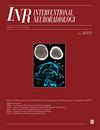选择性动脉内低温疗法联合血管内血栓切除术治疗大血管闭塞:系统回顾和荟萃分析。
IF 1.7
4区 医学
Q3 Medicine
引用次数: 0
摘要
背景系统性治疗性低温可改善急性缺血性中风后的预后,但会增加并发症。理论上,在血管内血栓切除术(EVT)中对缺血部位进行选择性动脉内低温治疗可降低风险,带来益处。我们在 Medline/PubMed、Embase 和 Cochrane 电子数据库中检索了评估选择性动脉内低温疗法作为大血管闭塞 (LVO) EVT 辅助疗法的安全性和可行性的研究。采用固定效应模型对效应大小和 95% 置信区间 (CI) 进行了汇总。对二进制变量计算了比值比(ORs),而对连续性数据则汇总了平均差(MDs)。其中,224 例(48.4%)患者接受了选择性动脉内低温辅助治疗,239 例(51.6%)患者仅接受了 EVT 治疗。选择性动脉内低温治疗可提高良好功能预后率(90天时改良Rankin量表[mRS] 0-2)(OR 2.07 [95% CI, 1.36 to 3.16]),降低最终梗死体积(MD, -20.96 ml [95% CI, -26.17 to -15.75])和严重残疾率(90天时mRS 3-5)(OR 0.44 [95% CI, 0.26 to 0.75])。包括无症状脑出血、死亡率、肺炎、凝血异常和动脉痉挛发生率在内的安全性参数在各组之间具有可比性。结论:初步证据支持选择性动脉内低温治疗与 EVT 联合治疗 LVO 的安全性和可行性。这种方法有望推动缺血性脑卒中神经保护策略的研究。本文章由计算机程序翻译,如有差异,请以英文原文为准。
Selective intra-arterial hypothermia combined with endovascular thrombectomy for large vessel occlusion: A systematic review and meta-analysis.
BACKGROUND
Systemic therapeutic hypothermia may improve outcomes after acute ischemic stroke but increases complications. Selective intra-arterial hypothermia at the ischemic site during endovascular thrombectomy (EVT) theoretically offers benefits with fewer risks. However, there is little clinical evidence to support this approach.
METHODS
We searched Medline/PubMed, Embase and Cochrane electronic databases for studies evaluating the safety and feasibility of selective intra-arterial hypothermia as an adjunct to EVT for large vessel occlusion (LVO). Effect sizes with 95% confidence intervals (CIs) were pooled using the fixed-effect model. Odds ratios (ORs) were computed for binary variables, while the mean differences (MDs) were pooled for continuous data.
RESULTS
Of identified records, five clinical studies involving 463 LVO patients (62.9% male) were included. Of those, 224 (48.4%) patients received adjuvant selective intra-arterial hypothermia, while 239 (51.6%) received EVT alone. Selective intra-arterial hypothermia resulted in higher rates of good functional outcome (modified Rankin scale [mRS] 0-2 at 90-days) (OR 2.07, [95% CI, 1.36 to 3.16]), and lower final infarct volume (MD, -20.96 ml [95% CI, -26.17 to -15.75]) and lower rates of severe disability (mRS 3-5 at 90 days) (OR 0.44 [95% CI, 0.26 to 0.75]). Safety parameters including rates of symptomatic intracerebral hemorrhage, mortality, pneumonia, coagulation abnormalities, and arterial spasm were comparable between groups.
CONCLUSIONS
The initial evidence supports the safety and feasibility of selective intra-arterial hypothermia when combined with EVT for LVO. This approach shows promise for advancing research on neuroprotective strategies for ischemic stroke.
求助全文
通过发布文献求助,成功后即可免费获取论文全文。
去求助
来源期刊
CiteScore
2.80
自引率
11.80%
发文量
192
审稿时长
6-12 weeks
期刊介绍:
Interventional Neuroradiology (INR) is a peer-reviewed clinical practice journal documenting the current state of interventional neuroradiology worldwide. INR publishes original clinical observations, descriptions of new techniques or procedures, case reports, and articles on the ethical and social aspects of related health care. Original research published in INR is related to the practice of interventional neuroradiology...

 求助内容:
求助内容: 应助结果提醒方式:
应助结果提醒方式:


